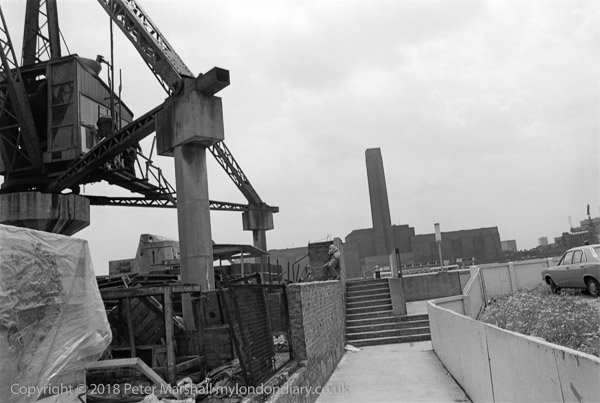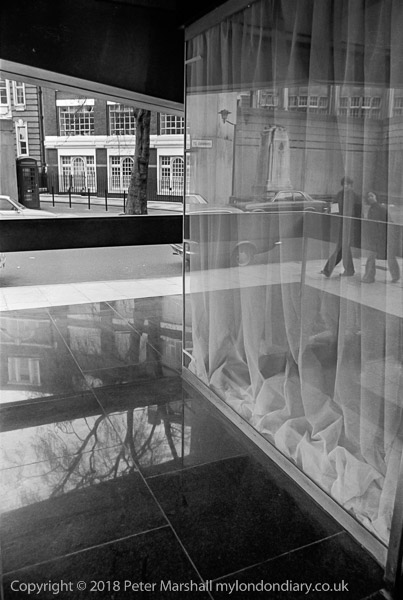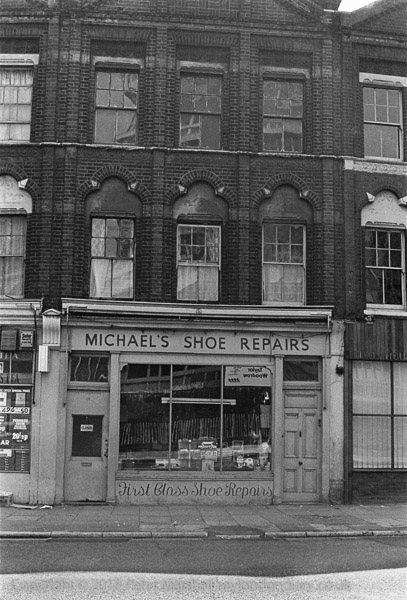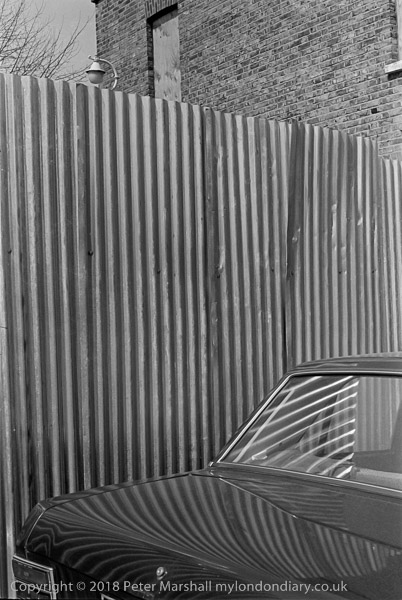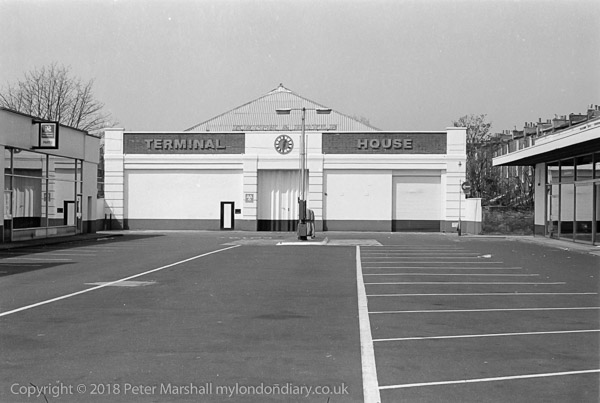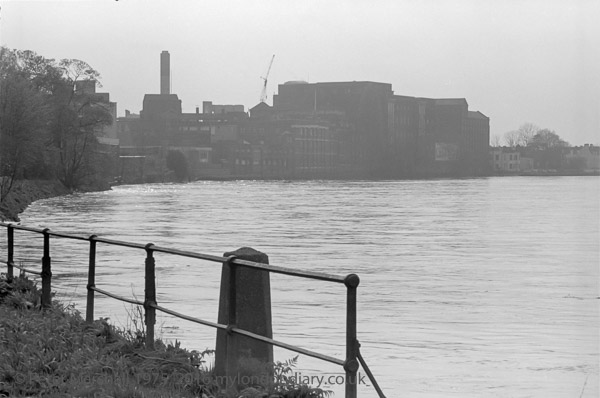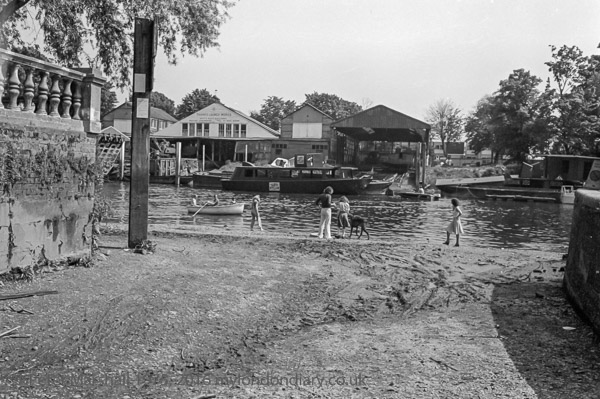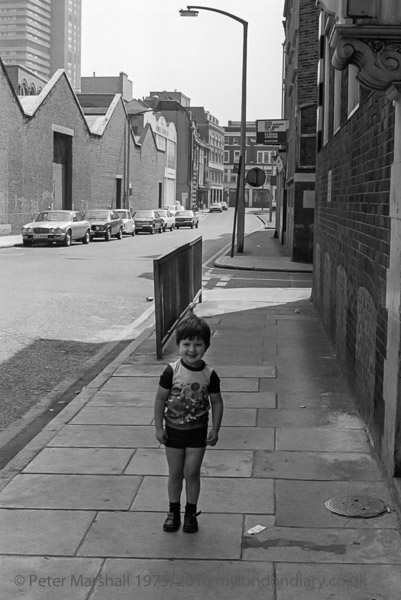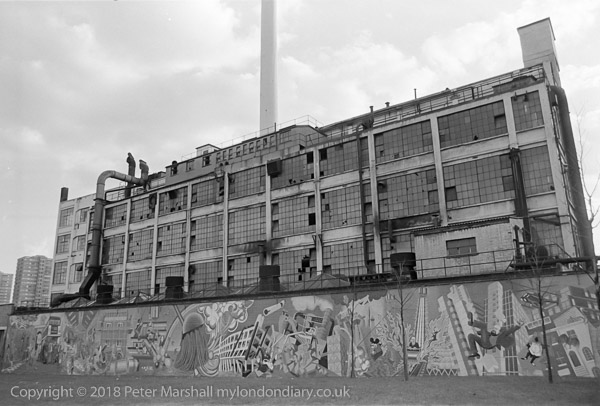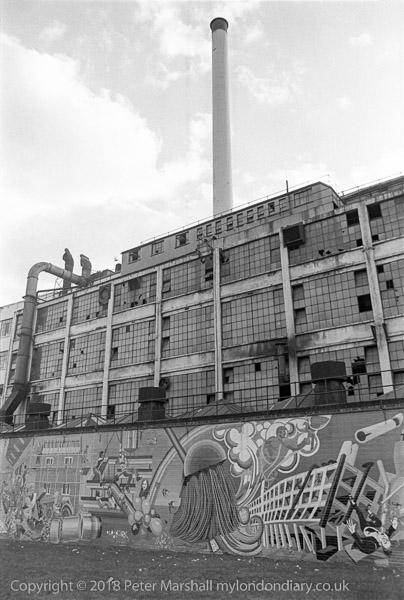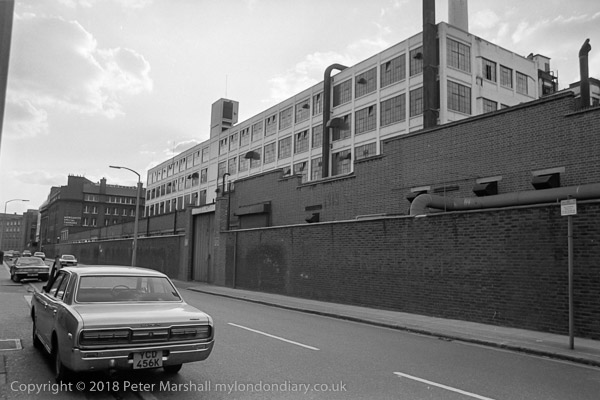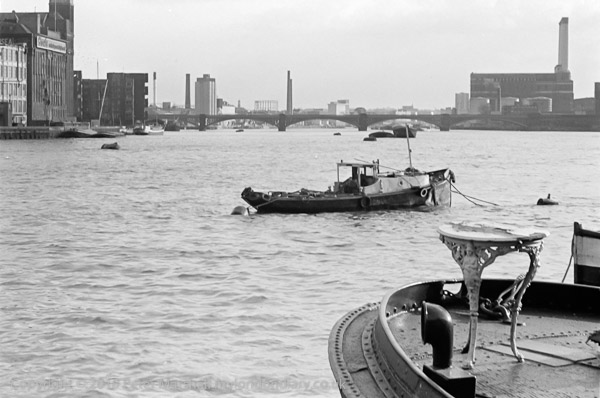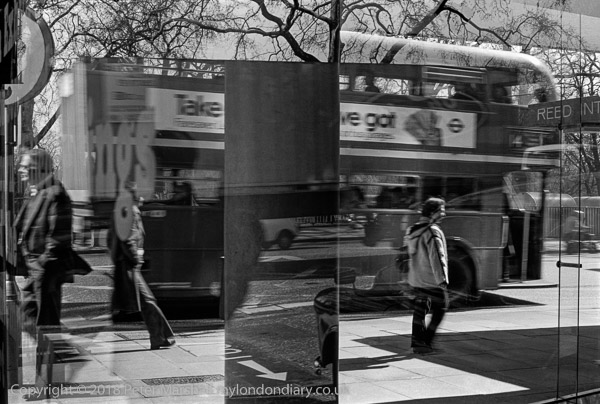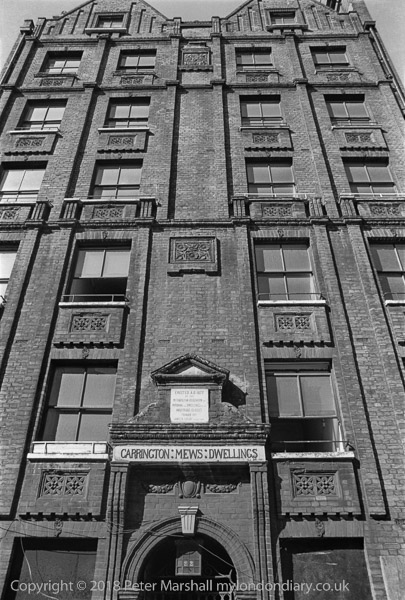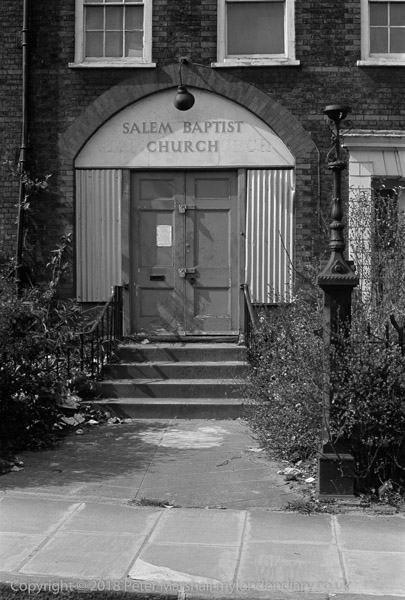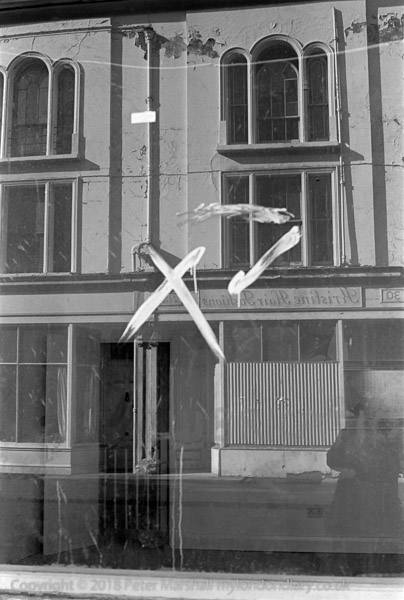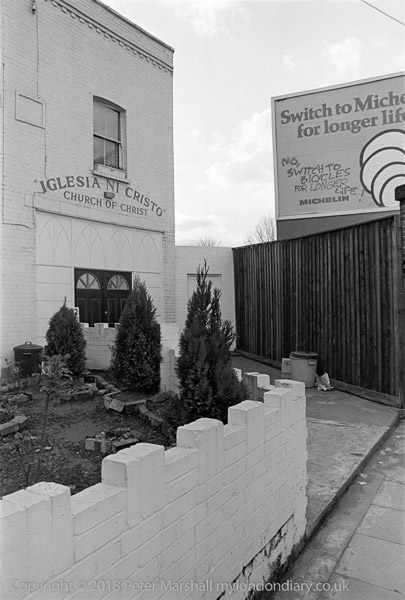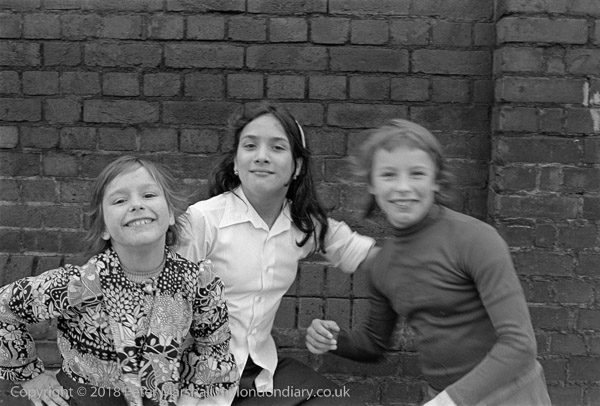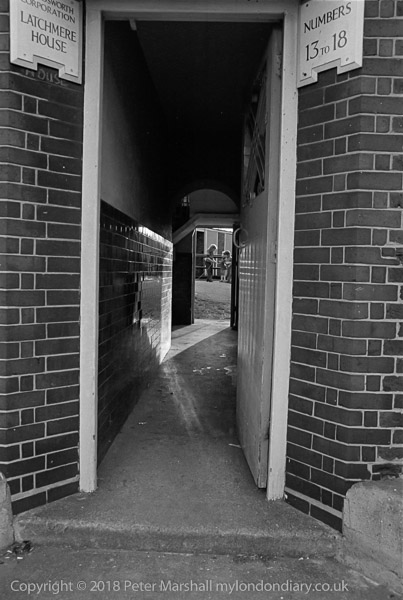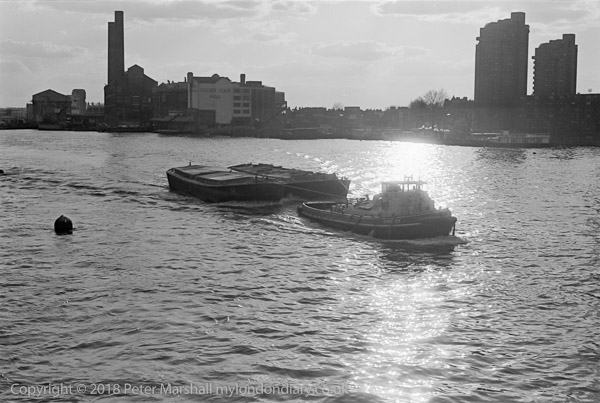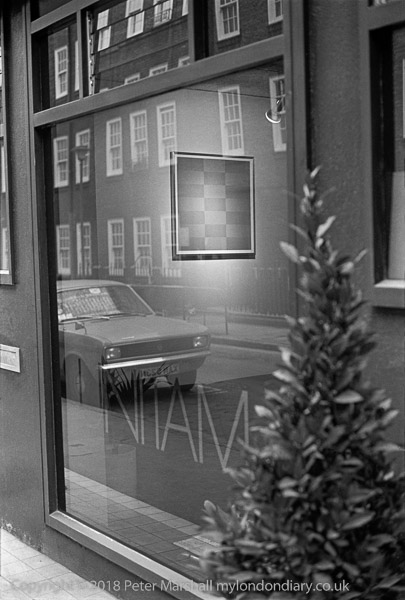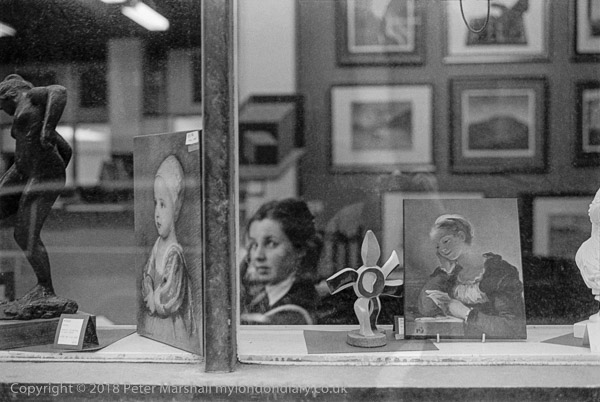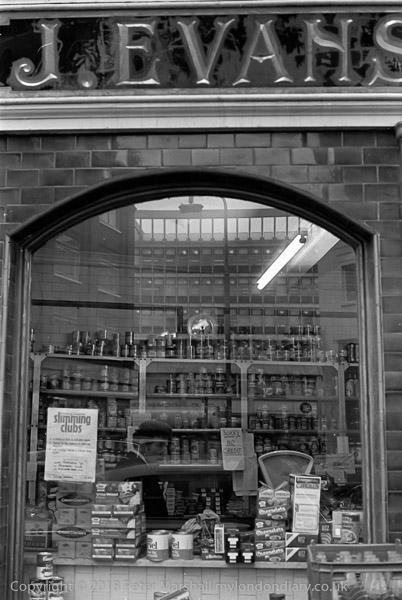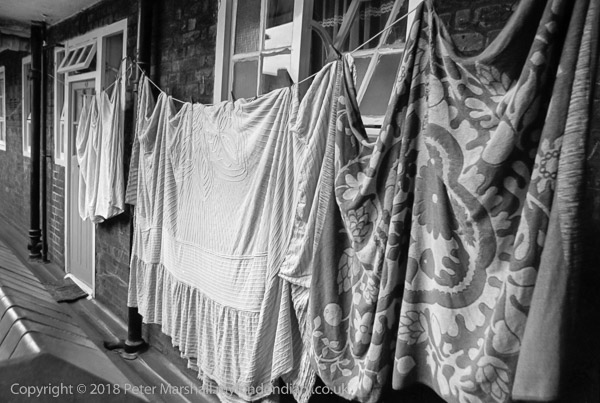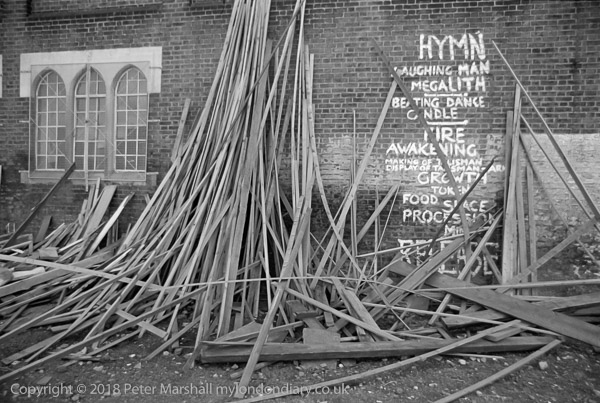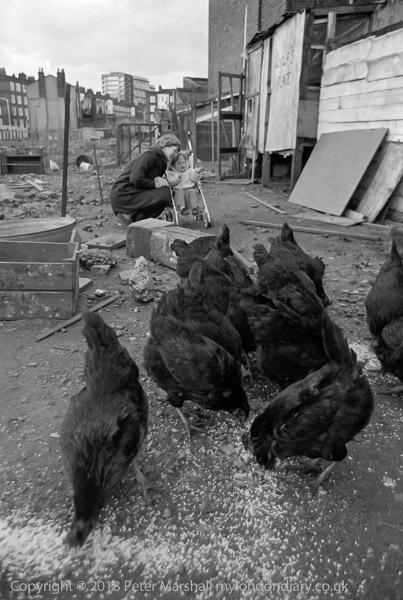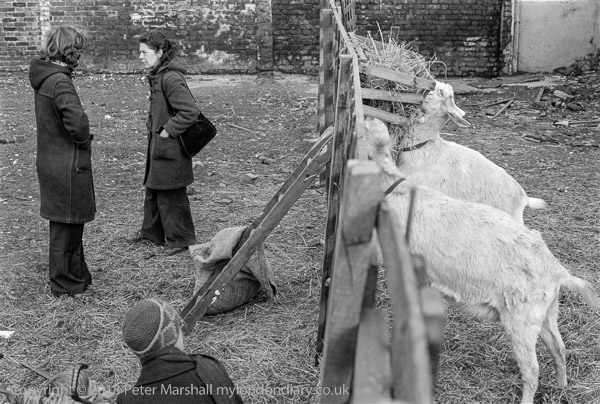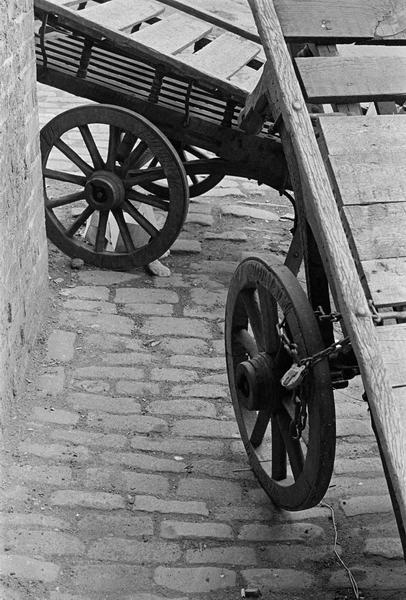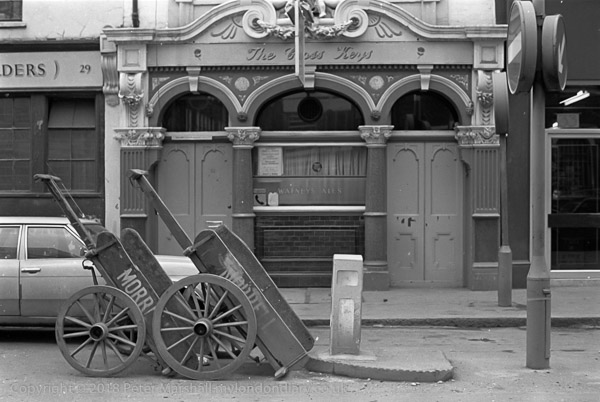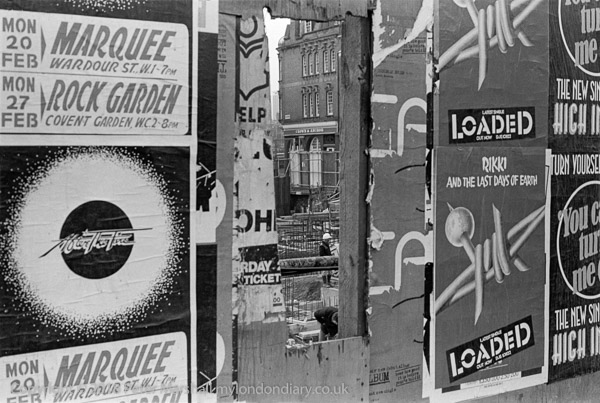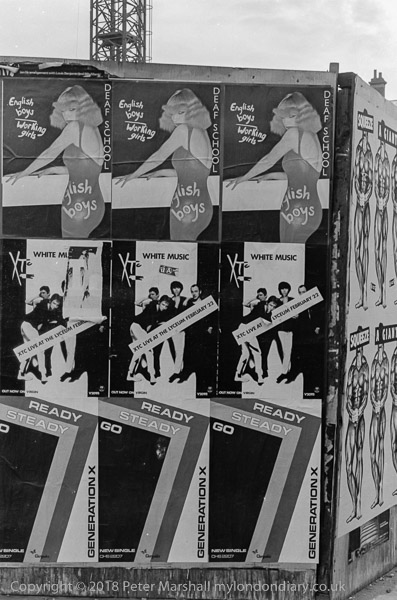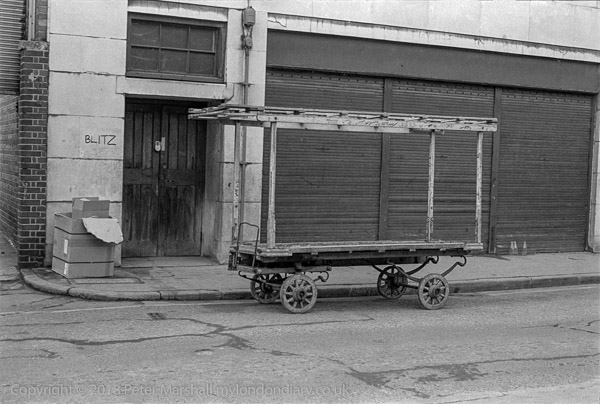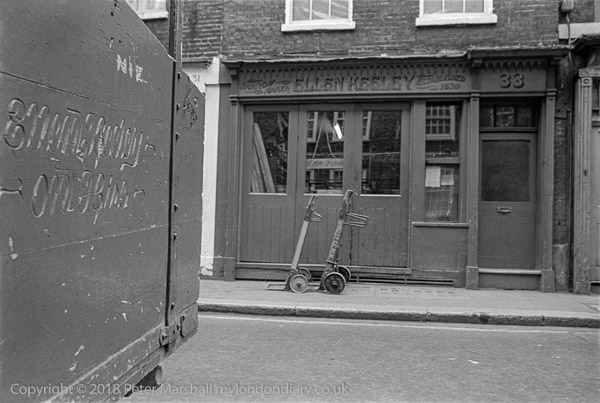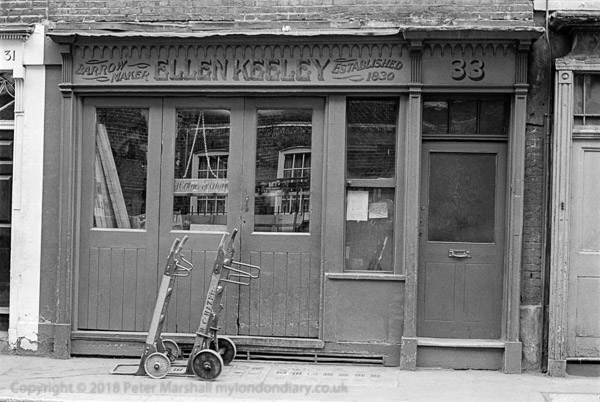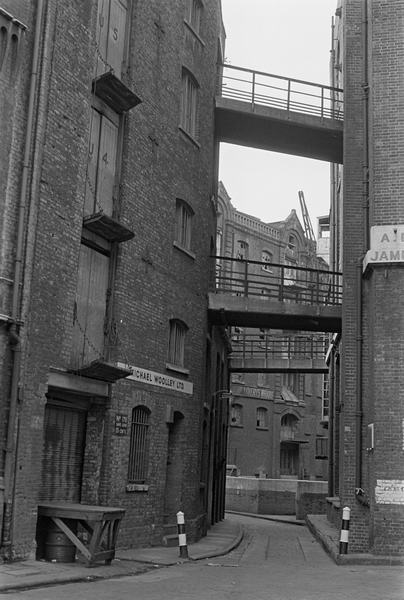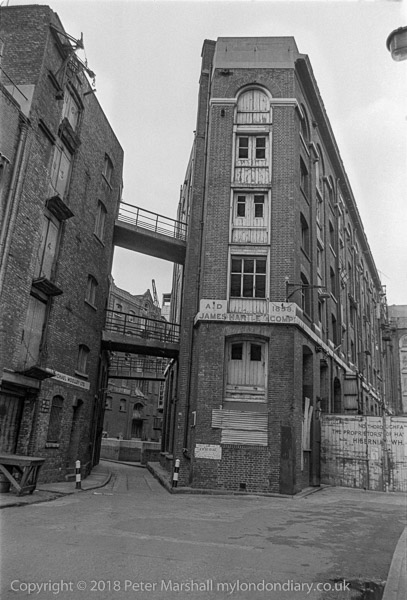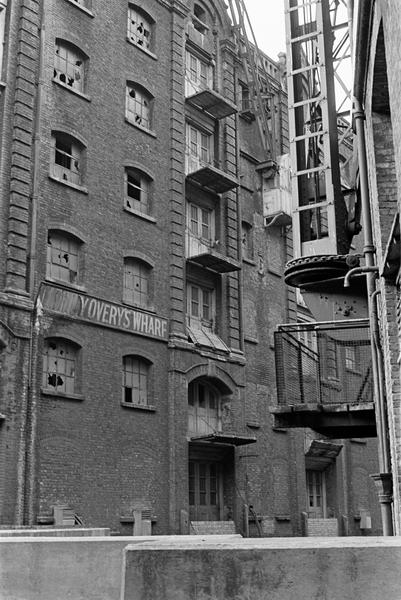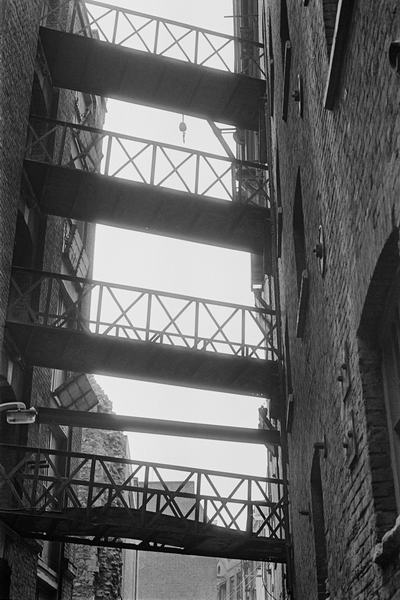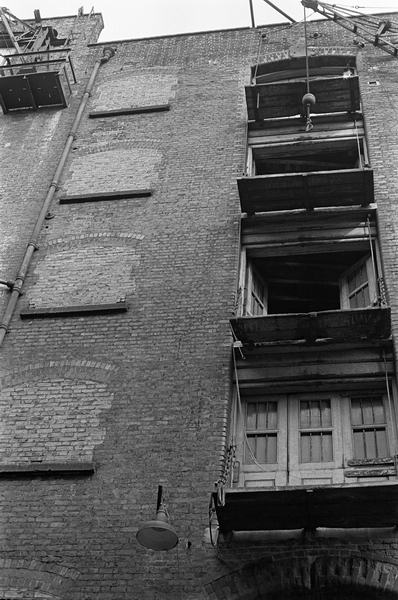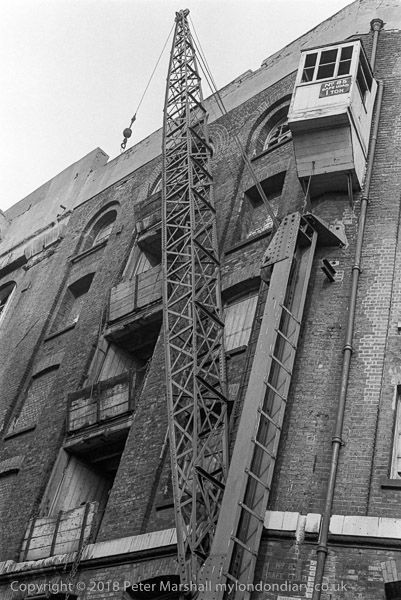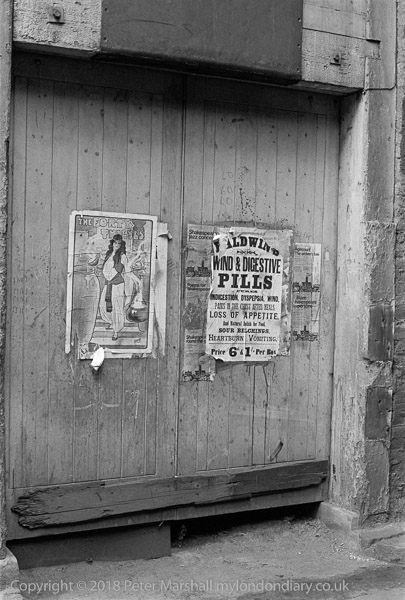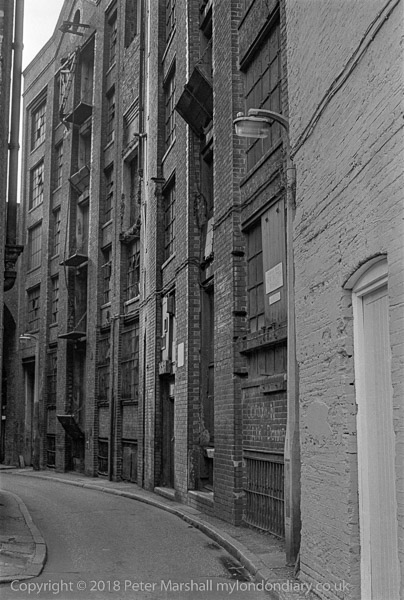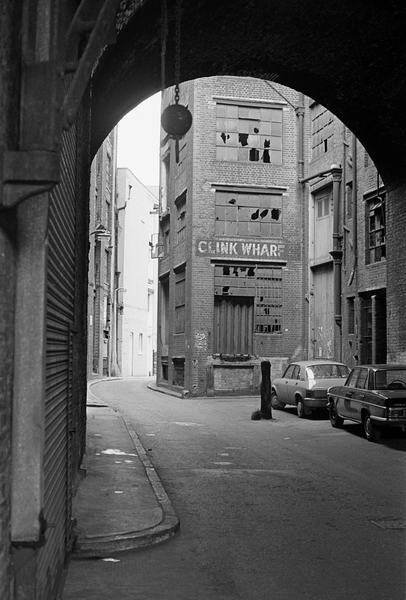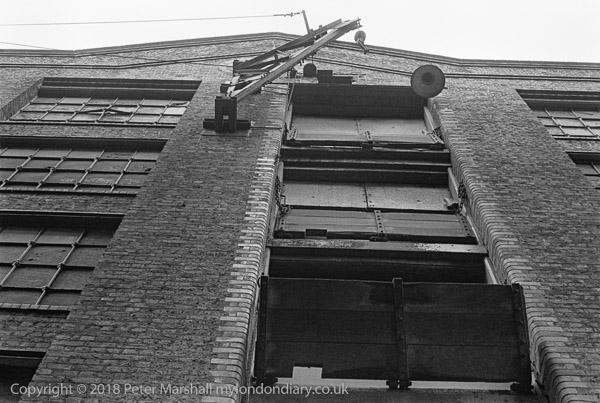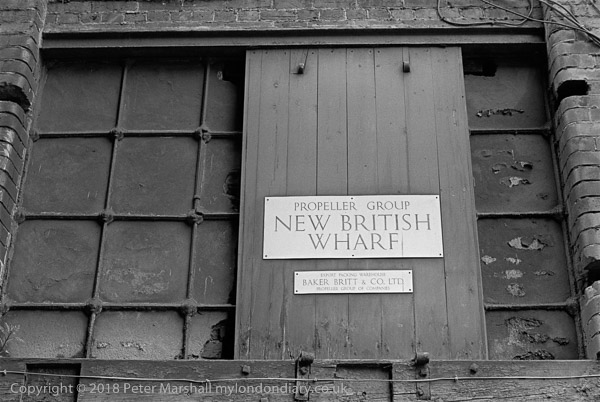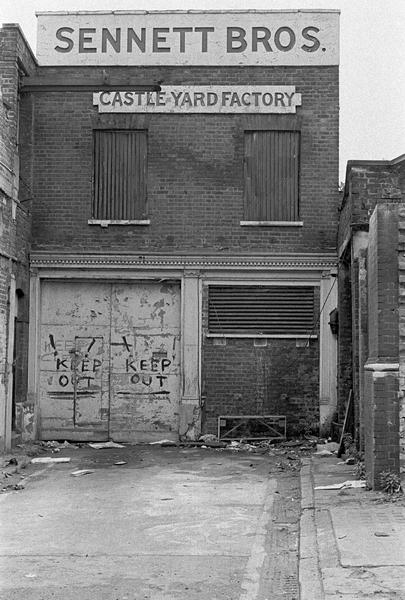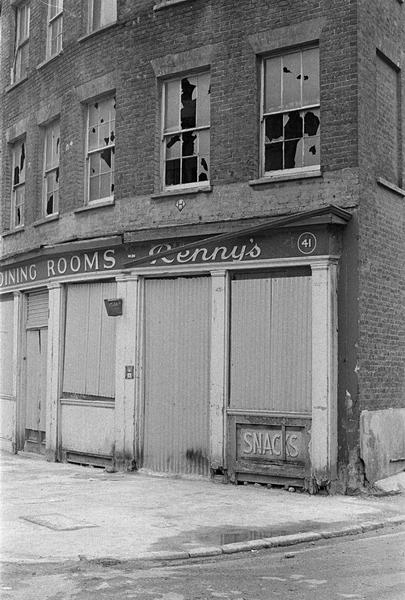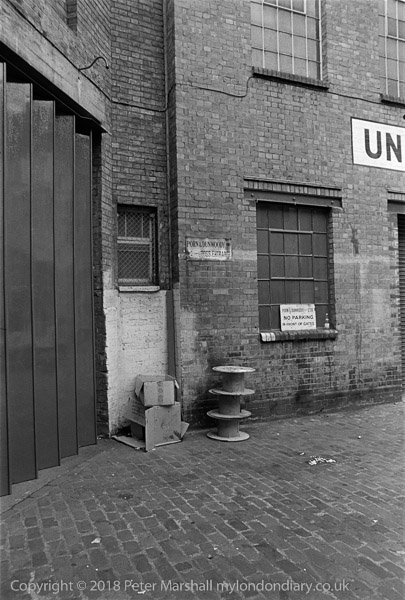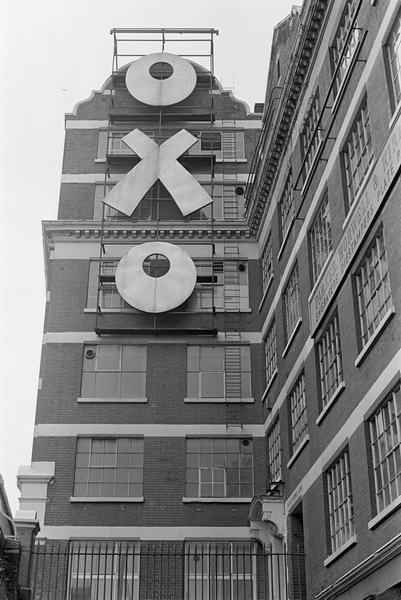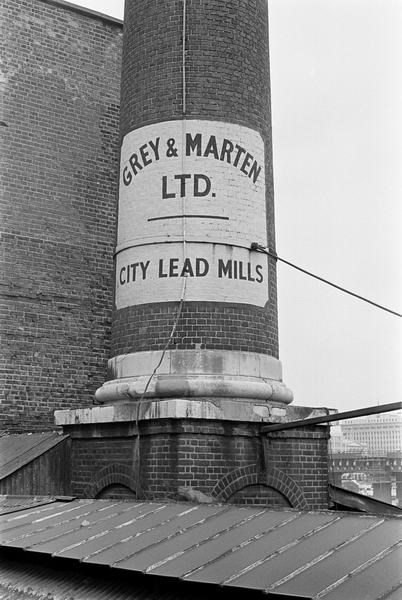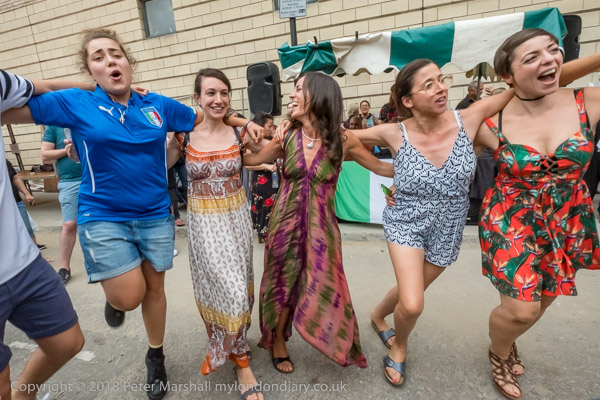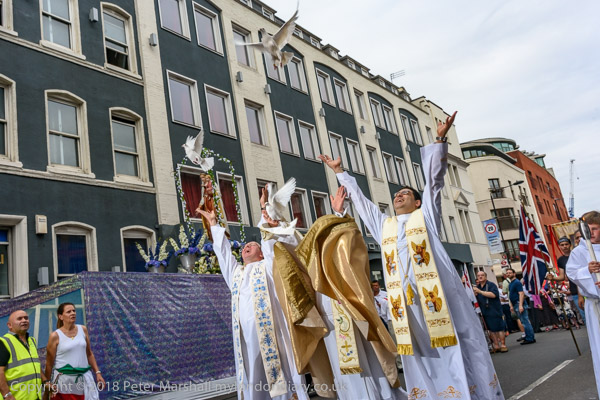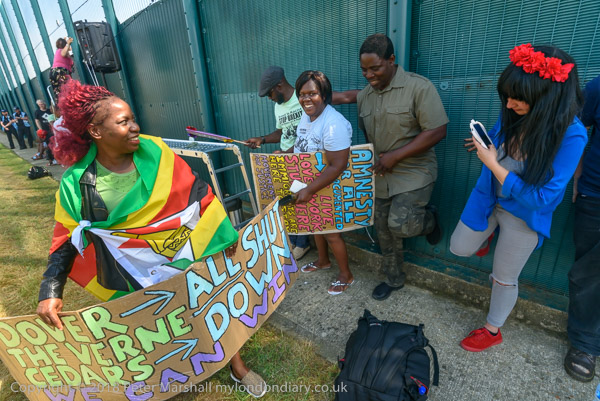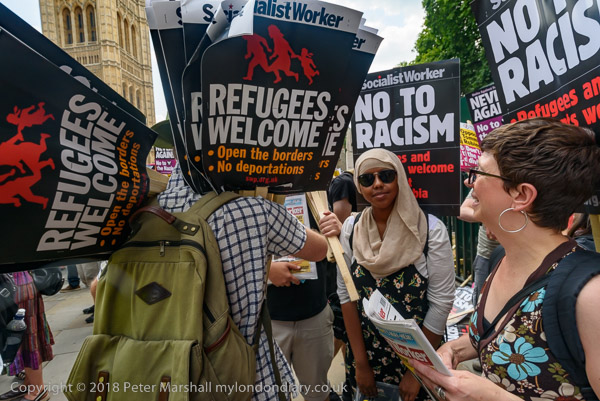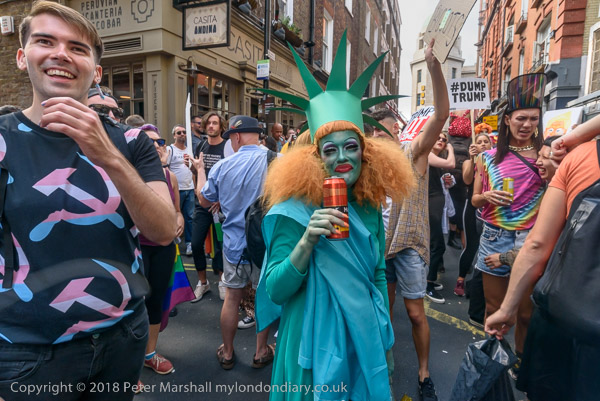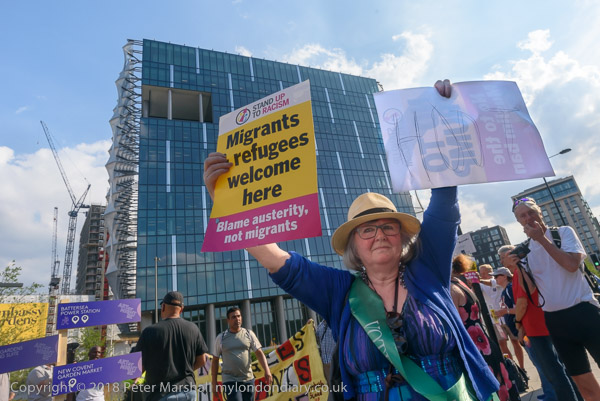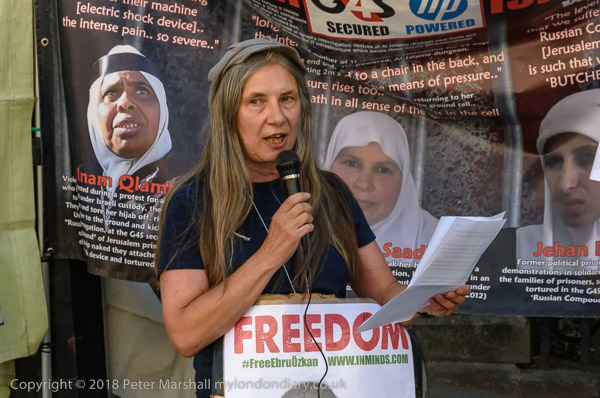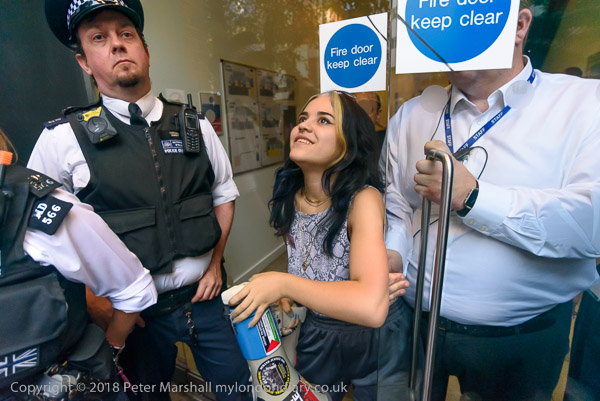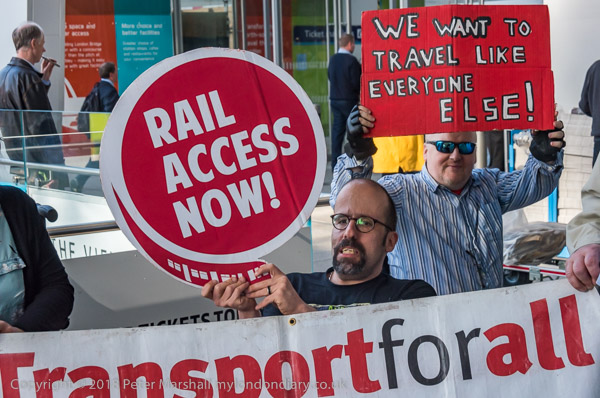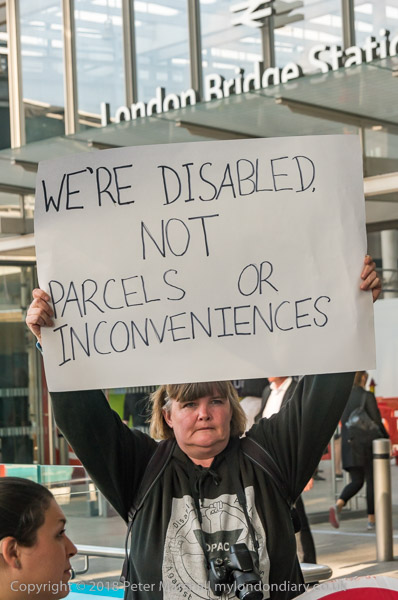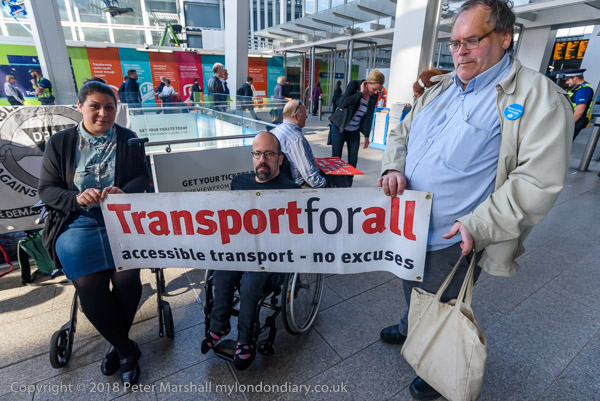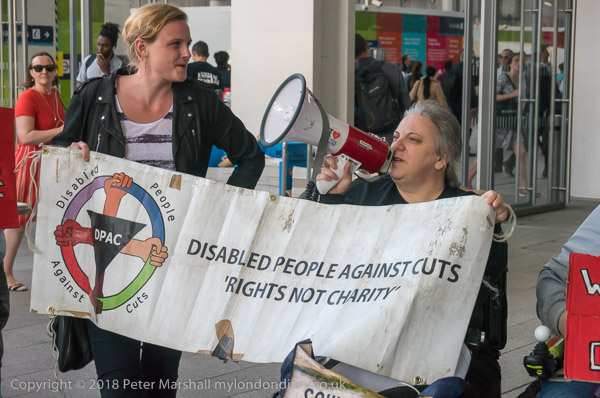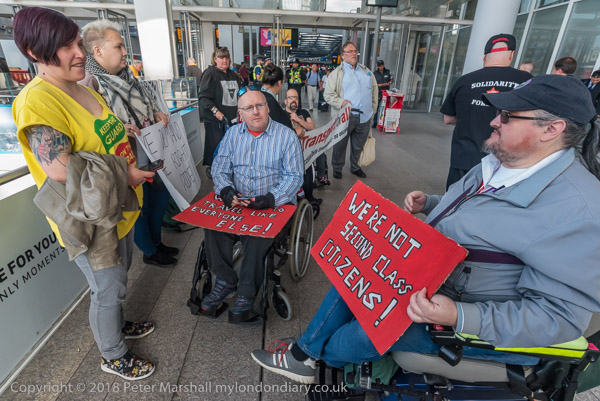Continuing my series of posts of my pictures from 1978 which will eventually include all of the selected photographs I took in London in 1978 and posted recently on Facebook with comments, and a few related images. All of these pictures (and more) are in my London Pictures web site, and eventually I intend to add the comments there too.
Click on any image to go to the web page – with a slightly larger picture for landscape format images.
__________________________________________
London 1978 (8)
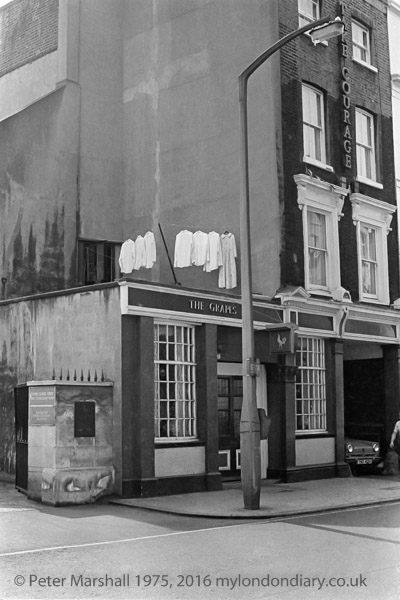
The Grapes, Borough High St, Southwark, 1978
15k36: Southwark, pub, Victorian
The Grapes, a Courage pub at 121 Borough High St since at least 1842, is still in business but has changed its name to St Christopher’s Inn, reflecting the name of an earlier inn on the site. The alley at right from which a car is emerging is Kentish Buildings (see below*.) The entrance at left is for Three Tuns House and Kings College Medical School. I think the main thing that prompted me to take this picture is the line of washing.
Courage’s Anchor Brewhouse was on the Thames at Horselydown Old Stairs, just to the east of where Tower Bridge was later built. John Courage bought ‘the Old Brewhouse’ and took over brewing there in 1787. Courage was a Scot whose family were Huguenots and had probably fled from Catholic persecution in France in the late 17th century. Even in its early years the brewery made use of its riverside position and shipped barrels of porter across the world. In 1955 it merged with the other great Southwark Brewery, the the Barclay Perkins brewery in Bankside (also confusingly referred to as the Anchor Brewery) and since then there have been a complex series of mergers and sales of the Courage Brand which (I think) is now owned by Marstons. Courage’s Anchor Brewhouse closed in 1981, with production moving to Simonds brewery near Reading, but I think Courage beers are now brewed by Charles Wells in Bedford. The Anchor Brewhouse has been converted into riverside apartments and a 1-bed flat there was sold recently for around £1.45 million, while the rather nice large penthouse on 5 floors with a fine view of Tower Bridge is on offer for £12.5 million.
To celebrate its 230 years of brewing, in 2017 Courage collaborated with the Southwark Brewing Company, a rather younger company set up in a railway arch in Druid St in 2014, to brew special limited editions of its cask ales back in Southwark for a year, with the final batch being released this month.
* ‘Borough High Street’, in Survey of London: Volume 22, Bankside (The Parishes of St. Saviour and Christchurch Southwark), ed. Howard Roberts and Walter H Godfrey (London, 1950), pp. 9-30.
British History Online http://www.british-history.ac.uk/survey-london/vol22/pp9-30 [accessed 21 February 2018] is a great source of information about the older buildings in Borough High St. It was originally published by London County Council in 1950 and has this to say about No. 121:
No. 121, The Grapes and Kentish Buildings
Kentish Buildings is a narrow court opening into Borough High Street between Nos. 121 and 123. On its northern side it still retains the red brick fronts of several 18th century houses. They are of three storeys, with steep tiled roofs, eaves, plain brick strings, and flush framed sash windows to the two upper floors. The ground floor has been reconstructed to form part of the Grapes public-house in Borough High Street.
The narrow entry to the yard is spanned by a four-storey 18th century building with wide sash windows at the back. The front has been cemented and altered out of character.
Until the beginning of the 19th century Kentish Buildings was known as Christopher Alley. It occupies the site of the inn yard of the Christopher, an inn marked on the plan of 1542, and probably so named after the patron saint of travellers, Saint Christopher. The first mention of the Grapes occurs in 1842.
Bankside Power Station across the River Thames, City of London, 1978
15l11: City of London, wharf, crane, power station
Bankside B Power Station generated electricity until 1981, but in its latter years oil-fired generation was uneconomic compared to coal-fired stations and by 1978 three of its four generators had been decommissioned and the fourth (and largest) down-rated and only used at times of peak demand.
This picture was taken from somewhere close to the north bank of the Thames, most probably just to the east of where the Millennium Bridge now stands and there are still steps down to the river from Paul’s Walk which I think are Trig Lane stairs.
Trig Lane is now a short private street off Broken Wharf, a street leading from High Timber St to the south from Queen Victoria St. Broken Wharf leads to the riverside Paul’s Walk and I presume the crane at the left of my picture is on Broken Wharf. The area to the right of the picture would then be where extensive archaeological excavations were carried from 1974-6 on this part of London’s medieval waterfront, with a report published by the London and Middlesex Archaeological Society in 1982.
According to a book on dissenting churches and meeting houses by Walter Wilson published in 1808, “Broken Wharf is so called from its being broken and fallen down into the Thames. Here stood the city brew- house, to which the void space of ground was given by Queen Elizabeth.” and he goes on to state that it also contained an old building which pumped the water supply for the middle and western parts of the city from the River Thames. Part of that same building was let to “the famous Mr. Hanserd Knollys, and his colleague, Mr Robert Steed” as a Baptist meeting house, but they moved elsewhere in 1691. Presumably the Thames came in handy for baptisms.
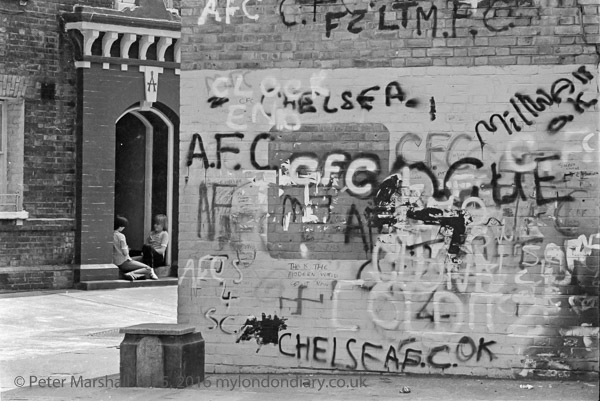
Peabody Wild St estate, Wild St, Covent Garden, 1978
15m41: Westminster, social housing, flat, children, Victorian
Taken on Wild St, just a few yards west of its end on Kingsway, this Peabody block with two people sitting in the doorway is still clearly recognisable, though there are a few minor differences. The door surround is now panted white, the graffiti has gone and there is now a fence across in front of that wall, with a post in the centre of the block in front of it. And hanging baskets on each side of the door.
Most of the wall then was covered with the names and initials of football clubs, but there are some more sinister markings, with a large NF, a spindly swastika and small somewhere at the top right, ‘HITLER RULES’. The Jam get a mention too, with ‘THIS IS THE MODERN WORLD GET IT NOW’, and smaller ‘THE MODERN WORLD GREAT NEW FANZINE’. Their second LP ‘This is the Modern World’ was recorded in late 1977 and released in November.
George Peabody (1795-1869) was an American banker who worked in London and came to love the city and one of a number of great Victorian reformers. He set up the Peabody Donation Fund in 1862 to “ameliorate the condition of the poor and needy of this great metropolis, and to promote their comfort and happiness” by providing model dwellings for the city’s poor, initially those living within 8 miles of the centre of the City at Royal Exchange, where there is a statue of him, unusually erected shortly before his death, by which time he had donated £500,000 to the fund.
The first Peabody estate opened in 1864 in Spitalfields and was soon followed by another in Islington. Legislation in 1875 enabled the Metropolitan Board of Works to carry out clearances of some of London’s worst slums and then to sell these sites to developers who had to build new estates in their place, and Wild St, built in 1882 was one of these, with 13 six-storey blocks.
Probably few of those displaced in the slum clearance found new homes in the Peabody blocks, but would instead have been displaced and moved into other slums, increasing their overcrowding. Peabody had strict rules for their tenants which included paying the rent every week on time and a nightly curfew. They were let to those who had regular jobs in the area, in the Covent Garden market, theatres, Fleet St newspapers, restaurants and offices.
When built there were toilets on the landings shared between flats and laundries on the upper floor. The Wild Street flats – now down to 11 blocks thanks to war damage – were modernised in the 1960s to make them self-contained.
The flats are now rather beyond the reach of the working poor, at least for new lets. Those eligible under the Westminster Council intermediate rent scheme, which gives at least a 20% reduction on private market rents to those eligible were recently offered a studio flat for £1100 per month – and would require a minimum household income of £33,000 to ‘achieve affordability’.
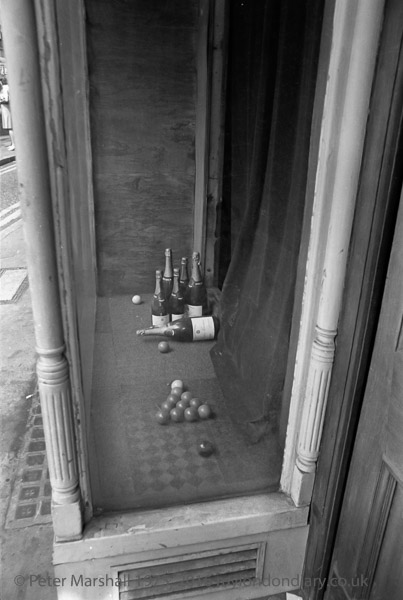
Club window, Bride Lane, City, 1978
15m62: window, drinking club, club, Victorian
I imagine from the window display that this club offered snooker as well as the Louis Kremer Champagne from Epernay. As champagne goes, Kremer is a relatively cheap house, though it dates from the mid nineteenth century, and now sells well in the supermarkets.
Bride Lane is at the centre of the old Fleet St, next to the newspapermen’s church of St Brides, the “Cathedral of Fleet Street“, and a short walk from other drinking holes such as the Cheshire Cheese, still an interesting pub to visit and where I’ve attended a few dinners with old friends. They used to serve some of the finest roast beef I’ve tasted, but my last visit was a disappointment, and I’ve not returned.
Further down the alley is another link to the past, The St Bride Institute which includes the St Bride Library, which began life in 1895 as the library for the printing school and newpaper industry and contains a great collection related to typography and printing. Unfortunately since 2015 this is only open on a very limited basis.
I think that the window I photographed has no disappeared, and that the club is now the premises of the “City of London Distillery opened on 20th December 2012 inside Jonathan Clark’s cocktail bar.”
I’ve never been a gin drinker, and it was a drink that caused much ruin in London, as Hogarth’s 1751 ‘Gin Lane’ illustrates, contrasting it with the much healthier and jolly ‘Beer Street’.
And Wikipedia tells me Dickens said in his ‘Sketches by Boz’:
“Gin-drinking is a great vice in England, but wretchedness and dirt are a greater; and until you improve the homes of the poor, or persuade a half-famished wretch not to seek relief in the temporary oblivion of his own misery, with the pittance that, divided among his family, would furnish a morsel of bread for each, gin-shops will increase in number and splendour.
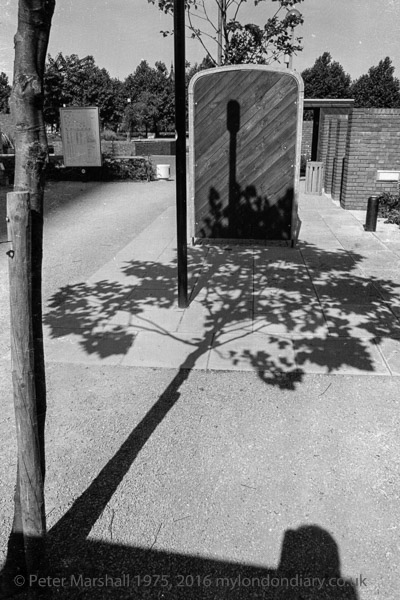
Street Furniture Display, Waterloo, Lambeth, 1978
16g44: Lambeth, street furniture
As a photographer who spent a lot of time on the streets I found the street furniture exhibition on what later became a car park to the west of the railway arches going across Belvedere Rd interesting and spent quite a while taking pictures. This neatly horizontal tree was certainly the best of them.
At that time an exit from the north end of Waterloo Station led to an elevated walkway across York Road and through the Shell Centre across Belvedere Road taking pedestrians to the South Bank. I suspect had the GLC not been vindictively abolished by Mrs Thatcher it would still be in place and its loss seems a significant if minor loss of the vision of a new post-war London to one where pure commercial interests are supreme. Heavily used then, it would now have been even more so, taking people rather more directly to the more recent footbridge across the river on the upstream side of the Hungerford Rail Bridge.
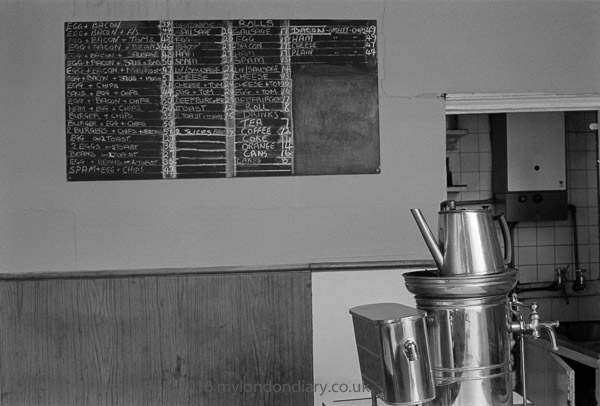
Crescent Cafe, Crouch End Hill, Hornsey, Haringey, 1978
16r26: cafe, Haringey
I didn’t go in the Crescent Cafe but had it been open I might well have been tempted to hand over 7p for a cup of tea, or even 17p on a Bacon Roll, though its unlikely I would have been hungry enough to deal with Egg + Bacon + Sausage + Toms, nor have been able to spare the 56p to pay for it. It seems nothing now, but money was very tight for me then though that 7p would only be around 38p allowing for inflation, so still a bargain.
It was however probably the highly detailed menu on the blackboard that attracted my attention, along with the shiny aluminium of the urn and teapot. I’m not sure why it was closed. Perhaps it was a Saturday or Sunday, or, as it was taken in August, perhaps the owners were taking their annual holiday, but the place was clearly still normally in business.
I can’t remember either what had taken me to north London, but I suspect I may have been carrying a large orange box of Agfa Record Rapid, following a visit to “the Brovira Boys of Muswell Hill”, Peter Goldfield and Martin Reed, who imported this holy grail of photographic paper into the UK, and published in 1978 ‘The Goldfinger Craftbook For Creative Photography’, now rather dated but available on-line. Later I got to know Peter, and wrote a short piece on my >Re:PHOTO blog when he died in 2009. Martin Reed went on to continue the work they started at Silverprint, for many years from 1984 in Southwark and still in business, though without Martin, in Poole and by mail order.
Record Rapid died so far as photographers were concerned around 1988, when Agfa were forced to re-formulate it without cadmium for health and safety reasons. Cadmium compounds are highly poisonous, and are still used in artists’ pigments, but while they are fixed on the surface of paintings, and thus safe unless artists licked their brushes, a considerable proportion ran off into the drains when photographic paper was processed, and their use was banned in most countries. Papers containing cadmium salts continued to be made in other countries for a few years but none achieved the properties of the old Record Rapid, and probably the closest approach to it now involves using some inkjet papers.
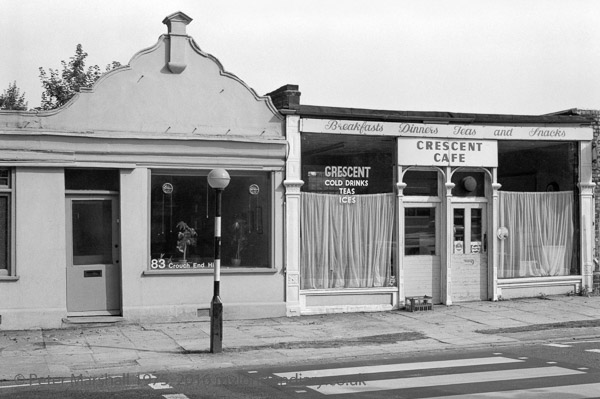
Crescent Cafe, 85 Crouch End Hill, Hornsey, Haringey, 1978
16s21: cafe, Haringey
The second picture of the Crescent Cafe was taken on a separate film, but made within a few second of the first, and I think with a Leica rather than the Olympus OM1 used for the other image.
I had been persuaded by Ray Moore and Paul Hill that a Leica might suit my way of working better than an SLR, and had bought an old and very worn Leica M2 body from Hove Camera, a specialist dealer in secondhand Leicas, at a cost of £170 (equivalent after inflation to £1024 now in 2018.) It was cheaper than the average M2 Leica at the time because of its condition, suggesting it had been through several wars. Its serial number tells me it was made in 1959.
Many preferred the M3, but the great advantage of the M2 was that it had the 35mm frame line in the viewfinder (and the whole visible area was a pretty good fit for a 28mm) and that you only see a single frame line at at time. For a while I only had one lens for it, a collapsible 50mm f2.8 Elmar, which was an excellent lens, except when I didn’t quite extend it properly, and made the camera just about fit in a very large jacket pocket. But the camera really came into its own later after I saved a month’s pay to buy a secondhand 35mm f1.4 Summilux which was a perfect match.
Hove Camera also published a series of camera guides, and although I think they stopped trading around 1999, the books which included republished Leica guides were acquired by Steyning Photo Books in 2007. The M2 is still in working order (I did once try to sell it, but because of its cosmetic condition the offer from a dealer was derisory) though it did need a rather expensive shutter service from Hove just over a year after I bought it. It still has that smoothly engineered feel that even more recent Leicas have been unable to match, and a better viewfinder. Fitting a cleverly engineered non-Leica rewind handle onto the knurled knob fixed the only real disadvantage compared to the later M4.
The empty crate waiting for the next milk delivery by the door is definite evidence that, though closed, the cafe will be open for business for breakfast on Monday.
The Crescent Cafe is still there, though it’s shopfront has changed, obscured by a large name board and a metal shutter. It changed its name for a few years to SERCEM, but was back to Crescent when I passed it last year. The menu as Sercem hadn’t changed a great deal, though a cup of tea was up to 90p and it also served a Turkish breakfast. The building to the left is now ‘Cornucopia Express’, and off-licence, grocery and greengrocers.
The Crescent Cafe gets its name from Crescent Rd opposite, and these buildings were almost certainly connected with Crouch End railway station, possibly the station master’s house. The station entrance to which was immediately to the right of the cafe.
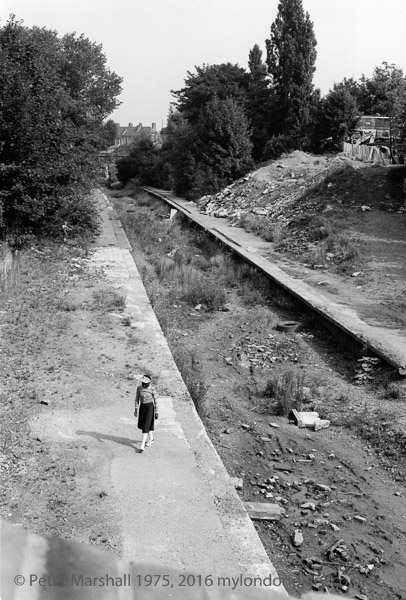
Former station, Crouch End Hill, Hornsey, Haringey, 1978
16s25: cafe, Haringey, station, walk
Immediately to the right of the Crescent Cafe had been the entrance to Crouch End station and the platforms were left when the station buildings were demolished.
The railway was opened by Great Northern in 1867 and the station was closed in 1951-2 with all passenger services on the line ending in 1954. There had been plans in 1935 to incorporate the line as a link between Finsbury Park and Highgate as a part of a more extensive development of the Northern Line, the Northern Heights Plan, but the war prevented the work starting and it was never taken up after the war, though it would have been a useful addition to the system. The line was used to move tube stock around after other traffic ceased, but around 1970 this was stopped as some of the bridges were unsafe, and the track was lifted at the start of 1972.
The station buildings on the bridge from which I took this picture were only demolished in 1977 when work was taking place on the bridge, though they had been largely destroyed in a fire a few years earlier, but the platforms were still in place. At road level the station was replaced by an odd and pointless architectural fixture, still in place, looking rather like an upside-down bridge, which puzzled me greatly at the time, and I took a number of photographs, none of them currently on this site.
I had intended to go down to the railway level, which is now a part of the Parkland Walk along the former rail line, plans for which had begun in 1976 but this section was not officially opened until 1984, and access from Crouch End Hill was fenced off when I took this picture. But as you can see from the picture it was accessible from elsewhere.
More to follow….
______________________________________________________
There are no adverts on this site and it receives no
sponsorship, and I like to keep it that way. But it does take a considerable amount of my time and thought, and if you enjoy reading it, a small donation – perhaps the cost of a beer – would be appreciated.
My London Diary : London Photos : Hull : River Lea/Lee Valley : London’s Industrial Heritage
All photographs on this and my other sites, unless otherwise stated, are taken by and copyright of Peter Marshall, and are available for reproduction or can be bought as prints.
To order prints or reproduce images
________________________________________________________
